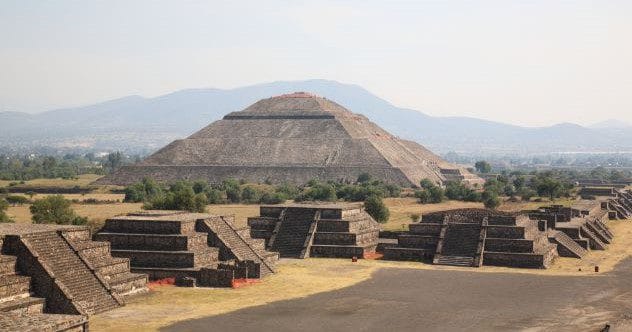Modern cities dazzle us with their towering skyscrapers and bustling streets. Yet, many of these vibrant hubs stand on foundations of ancient civilizations, offering a unique blend of contemporary life intertwined with historical depths. Visiting these cities is an extraordinary experience, where each site serves as a gateway to the past. Their ancient ruins add allure and provide a cultural and historical richness that shapes their identities.
10 Modern Cities Built on Ancient Ruins
Here are ten cities around the world that showcase the harmonious coexistence of ancient ruins and modern life, each offering a profound journey through time.
Lima, Peru
Lima, the vibrant capital of Peru, seamlessly blends modern features with a deep-rooted history. Home to a third of Peru’s population, this bustling metropolis serves as a key center for commerce and transportation. Despite its modern skyline, Lima’s history stretches back to around AD 1400 when the Incas established settlements in the region. Many of these early Inca sites lay hidden, buried beneath centuries of urban expansion.
In the 1950s, archaeological work unearthed remnants of Lima’s ancient heritage. Among the most remarkable sites is Huaca Huallamarca, a pre-Columbian adobe pyramid. Located in the city’s heart, this ancient structure contrasts starkly with Lima’s contemporary landscape. Huaca Huallamarca offers a glimpse into the city’s distant past, reminding us that modern Lima rests upon layers of Inca history.
Mexico City, Mexico
Mexico City, the largest urban center in North America, boasts a rich historical tapestry woven into its foundation. Originally Tenochtitlán, the thriving capital of the Aztec Empire, remnants of this ancient civilization are interwoven throughout the modern cityscape. The Templo Mayor, a major Aztec temple, stands as a testament to the city’s indigenous roots, revealing the Aztec’s architectural and spiritual legacy.
Further evidence of ancient life lies at the Cholula Archaeological Zone, where visitors can view remnants of the world’s largest pyramid, even surpassing the Great Pyramid of Egypt in size. Excavations reveal an extensive labyrinth of tunnels beneath what appears to be a natural hill topped by a colonial church. These historical layers tell the story of Mexico City’s evolution from an indigenous stronghold to a thriving modern capital.
Rome, Italy
Rome, the “Eternal City,” seamlessly merges modern vibrancy with a legacy that spans nearly three millennia. Founded in 753 BC, Rome has been continuously inhabited, making it one of the oldest cities in Europe. The grandeur of ancient Rome remains evident in iconic structures like the Colosseum, which hosted gladiator contests nearly 2,000 years ago. The Roman Forum showcases relics from the time of Julius Caesar and Augustus.
Today, approximately 90% of ancient Rome lies buried beneath the city’s contemporary streets. The Pantheon, a marvel of ancient engineering, offers insight into Rome’s architectural achievements. Rome’s mix of ancient and modern life creates an immersive experience, drawing visitors eager to walk in the footsteps of emperors and artists.
Istanbul, Turkey
Istanbul, Turkey’s cultural and economic heart, has a rich history, reflecting its strategic position between Europe and Asia. Originally Byzantium, the city became Constantinople under Roman rule and later transitioned into Ottoman rule. Istanbul’s ancient roots are visible with exploration. Beneath its modern structures are traces of empires, creating a blend of old and new.
Among Istanbul’s notable ancient sites is the Basilica Cistern, built by Emperor Justinian in the 6th century. Visitors encounter dimly lit columns and echoing splashes of water. The Column of Constantine and the Valens Aqueduct attest to the city’s Roman and Byzantine heritage. These sites serve as reminders of Istanbul’s historical significance.
Madurai, India
Madurai, one of India’s oldest cities, lies on the banks of the River Vaigai in Tamil Nadu. Known as the “city that never sleeps,” Madurai has a history spanning over 2,500 years. It serves as Tamil Nadu’s cultural capital, blending ancient traditions with modern urban life. Madurai’s vibrant temples and bustling markets reflect its historical importance.
Madurai is home to the Tirumalai Nayakkar Palace, reflecting the architectural achievements of the Nayak dynasty. Remnants of ancient settlements and temples showcase the influence of various rulers. Each monument reflects the city’s artistic heritage. Madurai’s blend of ancient ruins and modern city life offers a journey into the region’s historical roots.
Xi’an, China
Xi’an, with a history stretching back over 3,000 years, reminds us of China’s ancient heritage. As one of China’s four great ancient capitals, Xi’an was the eastern starting point of the Silk Road. Today, ancient city walls encircle its old town, offering glimpses into its military and architectural past.
The Terracotta Army, discovered in 1974, features thousands of life-sized clay soldiers crafted to guard Emperor Qin Shi Huang’s tomb. Each soldier reflects the artistry of the Qin Dynasty. This UNESCO World Heritage Site blends the grandeur of ancient dynasties with Xi’an’s modern streets.
Kyoto, Japan
Kyoto, once the imperial capital of Japan, serves as a gateway to the country’s history and culture. Founded in 794 as Heian-kyō, Kyoto was Japan’s capital for over 1,000 years. Today, its ancient shrines, temples, and gardens evoke a timeless atmosphere. Its historic architecture attracts millions each year.
Among Kyoto’s ancient sites are the Oeyama Historic Tomb and the Uenoyama Tumulus. Visitors explore the Kiyomizu-Dera Temple and Fushimi Inari Shrine. These structures offer an escape into Japan’s spiritual heritage, where Kyoto’s modernity blends seamlessly with its historical reverence.
Athens, Greece
Athens, the birthplace of democracy, harmoniously blends ancient and modern life. Founded over 5,000 years ago, Athens remains deeply connected to its ancient past. The Parthenon rises atop the Acropolis, symbolizing ancient Greek civilization. Temples, plazas, and ancient theaters tell stories of philosophers like Plato and Socrates.
Beyond the Acropolis, sites like the Temple of Olympian Zeus showcase Athens’ historical grandeur. These ancient landmarks remain central to its identity, attracting visitors eager to explore its legacy. Athens exemplifies the balance between a contemporary city and a place steeped in mythology and history.
Barcelona, Spain
Barcelona, famous for its Catalonian culture, is rooted in Roman history. Originally a Roman military colony known as Barcino, Barcelona’s ancient past resonates through its architecture and ruins. The Barcelona City History Museum allows visitors to descend into the remains of Roman streets and buildings.
The Temple of Augustus offers a connection to Barcelona’s Roman legacy. Built in the first century BC, this temple once stood at the heart of Roman Barcino. The city’s rich Roman heritage blends with modern architecture, creating an experience where ancient walls coexist with a vibrant metropolis.
Cairo, Egypt
Cairo, the largest city in the Arab world, is steeped in the ancient history of Egypt. As the gateway to early civilizations, Cairo lies near the Giza Plateau, where the Pyramids of Giza and the Great Sphinx stand. These monuments date back over 4,500 years, linking to Egypt’s Old Kingdom. Cairo’s streets feature bazaars, mosques, and markets that capture its blend of ancient and modern life.
The Egyptian Museum houses antiquities, including treasures from King Tutankhamun’s tomb. The Grand Egyptian Museum promises an extensive exploration of Egypt’s past. Cairo’s proximity to these wonders attracts visitors eager to uncover Egypt’s mysteries.
These ten cities offer a unique opportunity to explore the seamless coexistence of ancient ruins and modern life. Each city provides a profound journey through time, inviting us to reflect on the layers of history that shape our present.
Which of these historical cities intrigues you the most? Leave your comment below and share your thoughts!










